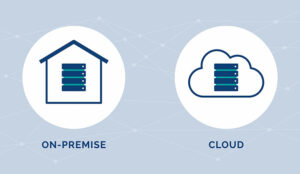As businesses adapt to a fast-changing world, they are increasingly moving key parts of the contact centre to the cloud. This shift accelerated during the pandemic lockdowns: with offices suddenly closing, companies were forced to move to home working.
Cloud-enabled systems allowed them to continue operating seamlessly. Now, post-pandemic this trend is continuing with contact centres using the cloud to support hybrid working and deliver increased agility alongside other benefits.
The State of Cloud Contact Centre Adoption
The ongoing transition to the cloud is one of the key areas highlighted in the ContactBabel 2022 UK Contact Centre Decision-Makers’ Guide, sponsored by Enghouse Interactive.
One of the central findings in the report is how the factors behind cloud migrations are changing. Instead of traditional reasons such as lowering costs and reducing pressure on IT, cloud migrations today are driven by more proactive considerations. Also, previous concerns, such as around security, have now been addressed.
For example, while in 2018 the second most popular reason for moving to the cloud was reducing CAPEX, this has now slipped to sixth in importance in 2021. Similarly, while in 2013, contact centres ranked worries around data security as their second biggest concern related to moving to the cloud, by 2021 this had fallen to seventh place.
5 Key Reasons for Embracing the Cloud
The report asked contact centres to rank their top reasons for moving to cloud-based solutions. There were five major insights:
- Disaster recovery/business continuity was ranked most important by the majority of respondents, with 49% of contact centres placing it in their top three. This is due to the growing importance of delivering customer service 24/7, especially after the disruptions caused by pandemic lockdowns.
- The need to support remote working ranked as the top reason for moving to the cloud by 1 in 6 contact centres, with 38% placing it among their top three. Again, this links to effectively supporting new hybrid ways of working.
- Replacing end-of-life technology appeared among the top three reasons given by 40% of respondents. This shows that when it comes to changing systems, the cloud is increasingly where replacements will be deployed.
- The need to increase functionality moved up from being the fifth most important reason for cloud migrations in 2018 to third in 2021. In fact, 42% placed this within their top three reasons, emphasising the need to offer a better customer experience across multiple channels.
- Supporting improved scalability received a top three ranking by 43% of respondents, again underlining the need for contact centres to be able to flex to meet changing interaction volumes.
Unlocking the Benefits of the Cloud
ContactBabel asked contact centres how embracing cloud-based solutions had benefited their business:
- 80% said they were able to access more powerful functionality by switching to the cloud.
- 72% felt that moving to the cloud made it easier to make changes to their systems.
- 63% believed the cloud had helped to reduce the overall cost of ownership of their contact centre technology.
The 7 Steps to a Successful Cloud Migration
So, with more contact centres now wanting to move solutions to the cloud, what is the best approach? To increase the chances of a successful cloud migration, you need to adopt a structured process. Here are seven steps you should include:
1. Define Your Needs and Goals
Goals could revolve around enhancing the customer experience to ensure happy, loyal customers. Alternatively, they could be more business focused objectives such as improving operational agility, increasing business continuity, or creating a scalable platform to support growth.
2. Identify the Challenges and Problems You are Solving
Challenges might be how to support home working agents or streamlining multi-site/global operations. Equally your challenge might be financial, with a need to only pay for the IT services that you use by moving to the cloud’s more flexible pricing model.
3. Assess Your Legacy Systems and how They Impact Your Choice of Cloud Solution
This is key since your incoming cloud platform will need to integrate with the solutions your contact centre already relies on. This could be your CRM software, ticketing, or other line-of-business systems.
4. Be Clear About Your “must-have” Features
For example, your key requirements might be to support skills-based routing, analytics, or omnichannel communications.
5. Select a Provider You can Trust
Your migration partner is key to helping you define and implement a realistic strategy tailored to your requirements. Make sure they have the capabilities and features that align with your needs.
6. Minimise Service Interruptions
Your migration strategy needs to ensure your service isn’t impacted. Therefore, try and reduce risk and complexity wherever you can. Consider an agile, phased delivery, instead of trying to do everything at once.
7. Monitor Success
Check the performance of your cloud-based systems. Choose success metrics around areas such as cost, time, business impact, governance, infrastructure, user experience and security.
Cloud solutions are now an increasingly vital part of every contact centre operation. Companies can see the wider benefits, beyond cost reduction – choosing the cloud to better support customer needs, aid home working and introduce new functionality.
Migrating to the cloud should therefore be key foundation for your contact centre technology strategy moving forward.
This blog post has been re-published by kind permission of Enghouse Interactive – View the Original Article
For more information about Enghouse Interactive - visit the Enghouse Interactive Website
Call Centre Helper is not responsible for the content of these guest blog posts. The opinions expressed in this article are those of the author, and do not necessarily reflect those of Call Centre Helper.
Author: Enghouse Interactive
Published On: 13th May 2022
Read more about - Guest Blogs, Enghouse Interactive






 Enghouse Interactive delivers technology and expertise to help bring your customers closer to your business through its wide range of customer contact solutions.
Enghouse Interactive delivers technology and expertise to help bring your customers closer to your business through its wide range of customer contact solutions. 




























